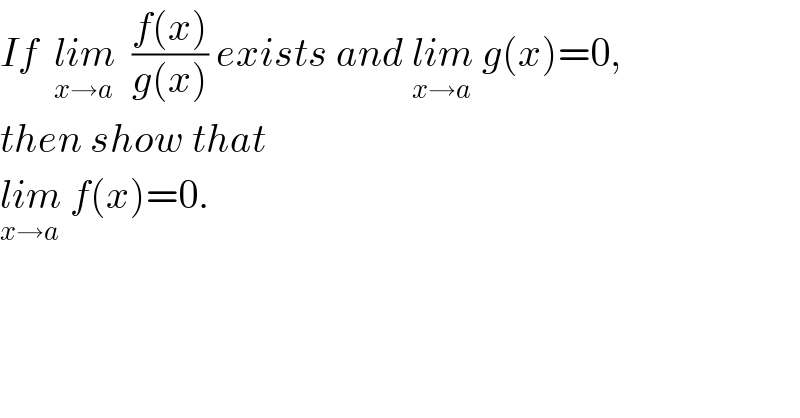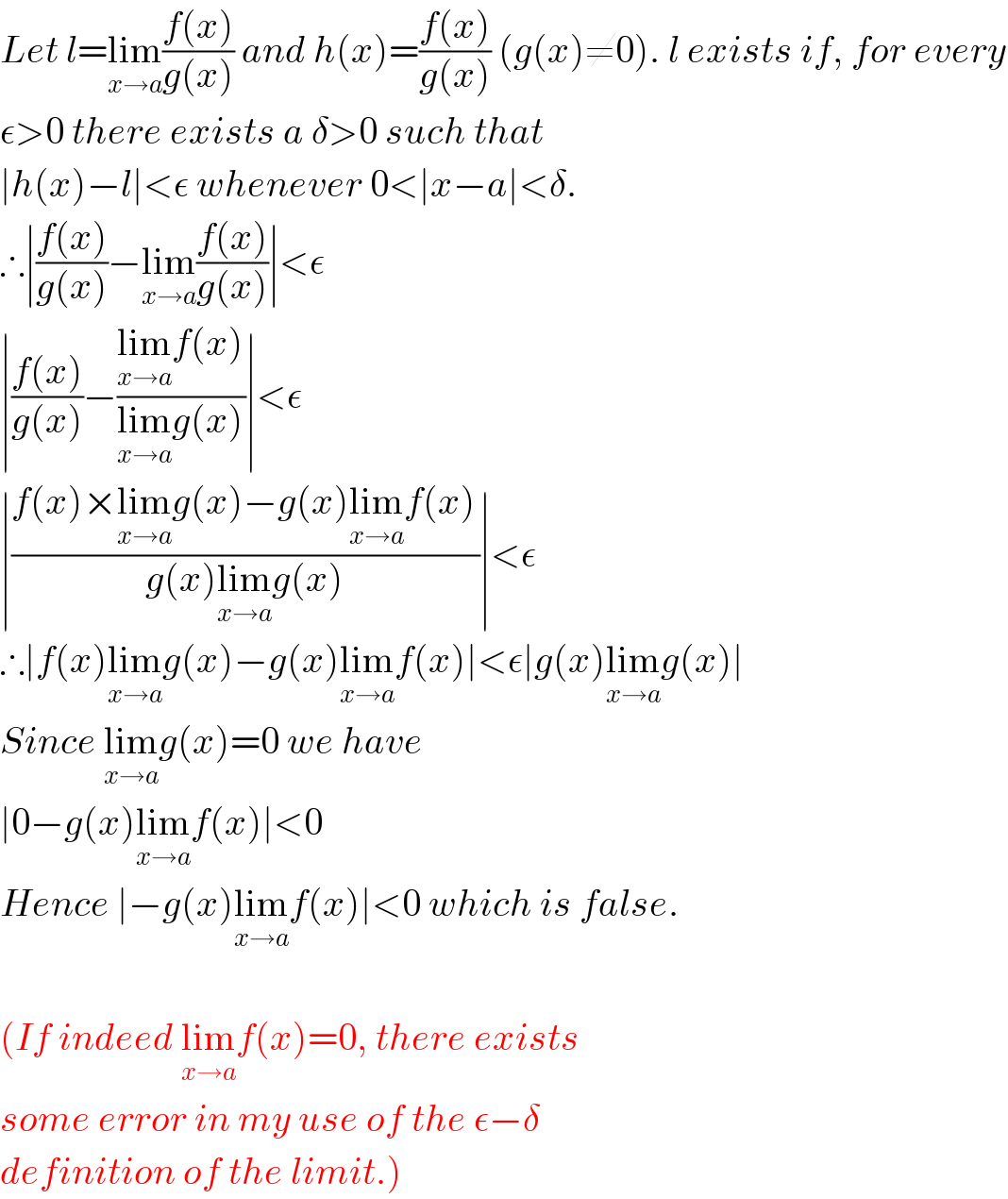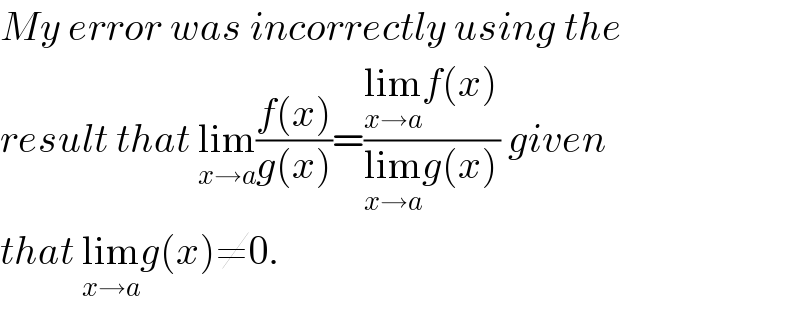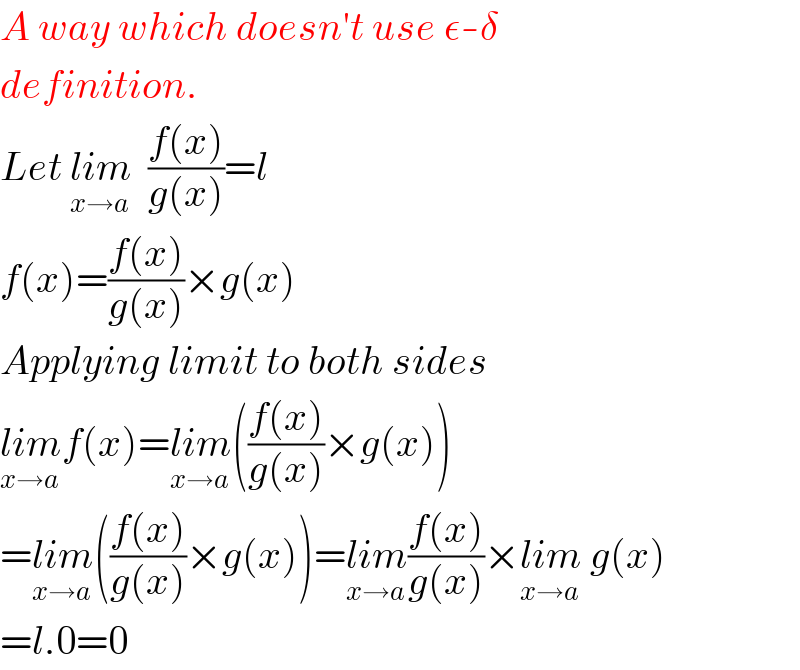Question Number 4363 by Rasheed Soomro last updated on 13/Jan/16

$${If}\:\:\underset{{x}\rightarrow{a}} {{lim}}\:\:\frac{{f}\left({x}\right)}{{g}\left({x}\right)}\:{exists}\:{and}\:\underset{{x}\rightarrow{a}} {{lim}}\:{g}\left({x}\right)=\mathrm{0}, \\ $$$${then}\:{show}\:{that} \\ $$$$\underset{{x}\rightarrow{a}} {{lim}}\:{f}\left({x}\right)=\mathrm{0}. \\ $$
Answered by Yozzii last updated on 13/Jan/16

$${Let}\:{l}=\underset{{x}\rightarrow{a}} {\mathrm{lim}}\frac{{f}\left({x}\right)}{{g}\left({x}\right)}\:{and}\:{h}\left({x}\right)=\frac{{f}\left({x}\right)}{{g}\left({x}\right)}\:\left({g}\left({x}\right)\neq\mathrm{0}\right).\:{l}\:{exists}\:{if},\:{for}\:{every} \\ $$$$\epsilon>\mathrm{0}\:{there}\:{exists}\:{a}\:\delta>\mathrm{0}\:{such}\:{that} \\ $$$$\mid{h}\left({x}\right)−{l}\mid<\epsilon\:{whenever}\:\mathrm{0}<\mid{x}−{a}\mid<\delta. \\ $$$$\therefore\mid\frac{{f}\left({x}\right)}{{g}\left({x}\right)}−\underset{{x}\rightarrow{a}} {\mathrm{lim}}\frac{{f}\left({x}\right)}{{g}\left({x}\right)}\mid<\epsilon \\ $$$$\mid\frac{{f}\left({x}\right)}{{g}\left({x}\right)}−\frac{\underset{{x}\rightarrow{a}} {\mathrm{lim}}{f}\left({x}\right)}{\underset{{x}\rightarrow{a}} {\mathrm{lim}}{g}\left({x}\right)}\mid<\epsilon \\ $$$$\mid\frac{{f}\left({x}\right)×\underset{{x}\rightarrow{a}} {\mathrm{lim}}{g}\left({x}\right)−{g}\left({x}\right)\underset{{x}\rightarrow{a}} {\mathrm{lim}}{f}\left({x}\right)}{{g}\left({x}\right)\underset{{x}\rightarrow{a}} {\mathrm{lim}}{g}\left({x}\right)}\mid<\epsilon \\ $$$$\therefore\mid{f}\left({x}\right)\underset{{x}\rightarrow{a}} {\mathrm{lim}}{g}\left({x}\right)−{g}\left({x}\right)\underset{{x}\rightarrow{a}} {\mathrm{lim}}{f}\left({x}\right)\mid<\epsilon\mid{g}\left({x}\right)\underset{{x}\rightarrow{a}} {\mathrm{lim}}{g}\left({x}\right)\mid \\ $$$${Since}\:\underset{{x}\rightarrow{a}} {\mathrm{lim}}{g}\left({x}\right)=\mathrm{0}\:{we}\:{have} \\ $$$$\mid\mathrm{0}−{g}\left({x}\right)\underset{{x}\rightarrow{a}} {\mathrm{lim}}{f}\left({x}\right)\mid<\mathrm{0} \\ $$$${Hence}\:\mid−{g}\left({x}\right)\underset{{x}\rightarrow{a}} {\mathrm{lim}}{f}\left({x}\right)\mid<\mathrm{0}\:{which}\:{is}\:{false}. \\ $$$$ \\ $$$$\left({If}\:{indeed}\:\underset{{x}\rightarrow{a}} {\mathrm{lim}}{f}\left({x}\right)=\mathrm{0},\:{there}\:{exists}\right. \\ $$$${some}\:{error}\:{in}\:{my}\:{use}\:{of}\:{the}\:\epsilon−\delta\: \\ $$$$\left.{definition}\:{of}\:{the}\:{limit}.\right) \\ $$
Commented by prakash jain last updated on 13/Jan/16

$$\underset{{x}\rightarrow\mathrm{3}} {\mathrm{lim}}\:\frac{{x}^{\mathrm{2}} −\mathrm{9}}{{x}−\mathrm{3}} \\ $$
Commented by Yozzii last updated on 13/Jan/16

$${My}\:{error}\:{was}\:{incorrectly}\:{using}\:{the}\: \\ $$$${result}\:{that}\:\underset{{x}\rightarrow{a}} {\mathrm{lim}}\frac{{f}\left({x}\right)}{{g}\left({x}\right)}=\frac{\underset{{x}\rightarrow{a}} {\mathrm{lim}}{f}\left({x}\right)}{\underset{{x}\rightarrow{a}} {\mathrm{lim}}{g}\left({x}\right)}\:{given} \\ $$$${that}\:\underset{{x}\rightarrow{a}} {\mathrm{lim}}{g}\left({x}\right)\neq\mathrm{0}. \\ $$
Answered by RasheedSindhi last updated on 14/Jan/16

$${A}\:{way}\:{which}\:{doesn}'{t}\:{use}\:\epsilon-\delta \\ $$$${definition}. \\ $$$${Let}\:\underset{{x}\rightarrow{a}} {{lim}}\:\:\frac{{f}\left({x}\right)}{{g}\left({x}\right)}={l} \\ $$$${f}\left({x}\right)=\frac{{f}\left({x}\right)}{{g}\left({x}\right)}×{g}\left({x}\right) \\ $$$${Applying}\:{limit}\:{to}\:{both}\:{sides} \\ $$$$\underset{{x}\rightarrow{a}} {{lim}f}\left({x}\right)=\underset{{x}\rightarrow{a}} {{lim}}\left(\frac{{f}\left({x}\right)}{{g}\left({x}\right)}×{g}\left({x}\right)\right) \\ $$$$=\underset{{x}\rightarrow{a}} {{lim}}\left(\frac{{f}\left({x}\right)}{{g}\left({x}\right)}×{g}\left({x}\right)\right)=\underset{{x}\rightarrow{a}} {{lim}}\frac{{f}\left({x}\right)}{{g}\left({x}\right)}×\underset{{x}\rightarrow{a}} {{lim}}\:{g}\left({x}\right) \\ $$$$={l}.\mathrm{0}=\mathrm{0} \\ $$
